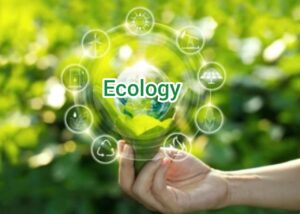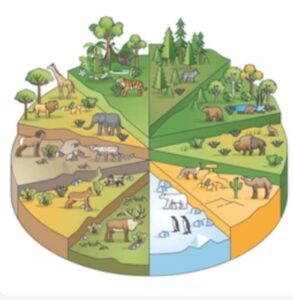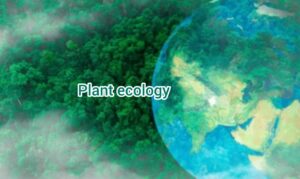Ecology is basically derived from a Greek word “Oikos” which means “dwelling place” and “Logos” Means” to study “and the word was firstly used by a German zoologist Ernst Haeckel called oecologic. It related to environment. Environment where organisms live which may be abiotic or biotic. Abiotic environment is also called physical environment and it is consist of things like wind, soil, water and temperature while biotic environment consist of plant human being, animals, insects etc. With the help of it we can understand the problems of life on earth and find out that how we can solve it in a sustainable way.

Definition
It is the branch of botany, in which we study about the relationship between living organisms with their surrounding environment
Types
It consist of a wide range of topics and approaches. We can understand the types of ecology by examined it. Most commonly ecologist subdivided it in to four different classes upon different limitations used. It can be divided on the basis of,
1. Solo interaction
2. Complexity
3. Habitat
4. Taxonomy
1. Solo interaction
Solo interaction is divided into two main types
1. Autecology
In autecology we study the relationship of individual organisms with their environment. For example, a person is studying on the effect of heavy metal pollution on 100 to 200 plants of sunflower on their growth and yield. He is studding only on single population of plants. This is autecology.
2. Synecology
In synecology we study the relationship of different communities with their environment. The growth behavior of individual plants in the environment is complex, one factor increases the effect of the other. These things work together. The complexity of the environment depends on the connected elements. Following factors are studied in synecology:
Ø Synecology studies several characteristics of society, such as its origin, structure, and function.
Ø Community history
Ø Community dynamics, as community are not fixed and change over time.
Ø The three levels of integration individual, population and the community are studied in community.
Synecology further divided into five types. These types are as follow:
2.1. Behavior
2.2. Population
2.3. Community
2.4. Ecosystem
2.5. Conservation
2.1. Behavior
In this type we study morphological, physiological ways of living organism in which their tolerance limits helps to determine the habitat of organism.
2.2. Population
In this type we study about the fluctuations that influence the distribution and abundance of different kind of organism lives at same place and make up an ecosystem. Its success will be determined by their ecological factors that make the genetic makeup of the population together. Population ecology will be better understand by determining its:
· Population growth
· Age distribution
· R and k species
· Dispersal
· Population density
2.3. Community
In community different population live at same place and are interconnected to each other. It’s just not a simple assemblage of a living organism in a particular area because living organisms have special type of dependence on each other not only in environment. That’s why they require a specific understanding among them.
2.4. Ecosystem
Ecosystem is the interaction of living and non-living substances. Living substances are plants, animals and bacteria while nonliving substances in the environment provides use energy, raw materials and space for the growths and development of living organisms. Ecosystem is divided into two main types:
1. Natural ecosystem
2. Artificial ecosystem
2.5. Conservation
In conservation we study about the methods and techniques which help to preserve our natural resources. Environment is a treasure trove of all the nutrients needed to sustain life on earth. Humans depend directly and indirectly on the environment for food, shelter, clothing, fuel, and other necessities of modern life. These things seem endless and few think they can be cured. Scientists understand that soon after the technological revolution, even the most resources can be destroyed, so the future of humanity depends on how we use the world’s resources wisely and try to preserve them for the people.
2. Complexity
On the basis of complexity which is increasing constantly is further divided into four types. These are:
1. Species
2. Population
3. Community
4. Ecosystem

2.1. Specie
Species is the study of how organisms interact with their living and non-living environment. Homo sapiens and E.coli are the examples .
2.2. Population
Population deals with understanding the patterns and process of change in a particular species over time or space. According to Clark there are two specific types of population. These are:
· Monospecific
· Polyspecific
2.3. Community
Community deals with the study of group of species that interact or can live together in a habitat. These communities are linked by a common ecosystem and each species can affect the other. That’s why community consist of two parts
· Mutual relationship among individual
· Mutual relationship with the environment
2.4. Ecosystem
Ecosystem deals with the study of ecosystems and biological components and their interaction in ecosystem. This science examines the functioning of living organism and relates them to their parts such as chemicals, rocks, soil, plants and animals.
3. Habitat
It can also be sub-divided into further different types according to their habitat conditions. These are:
1. Marine
2. Fresh water
3. Terrestrial
3.1.Marine
In marine we study the interaction of living organism present in the ocean with their environment.
3.2.Fresh water
Freshwater is the study of the structural and functional interrelationships of fresh water organisms as affected by their dynamic physical, chemical, and biological environments.
3.3.Terrestrial
In terrestrial we studies the terrestrial organism ,their populations and ecosystems, their relationships with the atmosphere, rivers and ground water, and the roles of the biochemical precursors carbon and nitrogen, energy, hydrology and circulation.
4. Taxonomy
It is also sub-divided on the basis of taxonomic categories of living organisms. These are:
1. Plant
2. Insect
3. Microbial
4. Vertebrate
4.1. Plant
In plant we study about the relationship of plants with their physical and nonliving environment where they live. Plant helps in the survival of mankind by fulfill of our basic needs of food and shelter.

It is further divide in to different types. These are:
-
Biosphere
-
Landscape
-
Plant population
- Community
- Ecosystem
- Plant population
- Plant ecophysiology
4.2. Insect
In insects we study about the relationship of insect with their surrounding environment. Insects are the prime sponsor of biodiversity.
4.3. Microbial
In microbial we examine the interaction of microbes with their physical environment.
4.4. Vertebrate
Vertebrate is the study of the availability of food in the environment and the use of this food by vertebrates.
Examples
Human ecology
It deals with the relationship between humans and all living things. He fascinates people, studies their behavior and considers evolutionary reasons for adopting certain behaviors.
It emphasizes humanity’s impact on the environment, and provides an understanding of the limits of all human beings and how we can improve ourselves to better ourselves and the environment
Niche construction
Niche architecture is an ecological model that involves the study of how organisms can adapt their environment to their advantage, as well as how they can help other organisms. This is of particular interest to ecologists who want to understand how specific organisms respond to stress.
A good example of this is how the caterpillars are well organized and ready to build mounds over 6 feet high while protecting and feeding the entire population at the same time. In their environment, bees recycle nutrients for plants. It provides a good ecological model because it deals with evolution and other unique factors related to populations, communities, and ecosystems.
Conclusion
In conclusion, the various types of ecology provide comprehensive insights into the intricate relationships between organisms and their environment. Each branch of ecology focuses on specific aspects of these interactions, contributing to our understanding of the natural world and guiding conservation efforts.
Autecology delves into the individual species’ adaptations and interactions, while synecology explores the collective dynamics of plant communities. Physiological ecology delves into the physiological responses of organisms to environmental factors, offering critical knowledge about their limitations and adaptations.
Population ecology investigates the dynamics of populations, shedding light on species distribution and conservation needs. Community ecology analyzes interactions between different species, influencing community structure and function.
Landscape ecology assesses the spatial patterns and connectivity of habitats, vital for understanding species dispersal and maintaining ecological balance. Plant ecophysiology uncovers the complex relationship between plant physiology and environmental factors, illuminating how plants cope with changing conditions.
Evolutionary ecology studies species’ long-term adaptations, revealing their ability to adapt to environmental challenges over time. Conservation ecology plays a pivotal role in safeguarding biodiversity and protecting threatened species.
Agroecology applies ecological principles to agriculture, promoting sustainable practices that benefit both crops and the environment. Finally, paleoecology reconstructs past ecosystems using fossil evidence, providing a historical context to understand long-term changes in the natural world.
By integrating knowledge from these diverse branches of ecology, scientists and policymakers can make informed decisions to protect and sustainably manage ecosystems. Ultimately, the multifaceted study of ecology is vital for fostering a harmonious coexistence between humanity and the natural world, preserving the planet’s biodiversity, and ensuring a sustainable future for generations to come.
FAQs
1. Question: What is autecology, and how does it differ from synecology?
Answer: Autecology is the study of individual plant species in relation to their environment, focusing on their adaptations, distribution, and interactions. Synecology, on the other hand, deals with the study of plant communities and their interactions as a whole.
2. Question: What is physiological ecology, and how does it explore the physiological responses of plants to environmental factors?
Answer: Physiological ecology examines how individual plants respond to environmental factors, such as temperature, light, water availability, and nutrient levels. It delves into plant processes like photosynthesis, respiration, and water uptake to understand their adaptations and limitations.
3. Question: What is the significance of population ecology in studying plant species dynamics?
Answer: Population ecology studies the dynamics of plant populations, including birth and death rates, growth patterns, and factors influencing population size. This knowledge is crucial for understanding species’ distribution and conservation efforts.
4. Question: How does community ecology explore interactions between different plant species within an ecosystem?
Answer: Community ecology examines the interactions between different plant species within a specific habitat or ecosystem. It investigates aspects like competition, predation, mutualism, and how these interactions influence community structure and function.
5. Question: What is the role of landscape ecology in understanding the spatial patterns and connectivity of plant communities?
Answer: Landscape ecology studies the spatial distribution and arrangement of plant communities across landscapes. It helps identify habitat fragmentation, corridors, and other landscape features that influence plant species’ dispersal and survival.
6. Question: How does plant ecophysiology investigate the relationship between plant physiology and environmental factors?
Answer: Plant ecophysiology explores how environmental factors impact plant physiology and vice versa. It investigates topics such as water-use efficiency, nutrient uptake, and carbon allocation in response to changing environmental conditions.
7. Question: What is the importance of evolutionary ecology in understanding the long-term adaptations of plant species?
Answer: Evolutionary ecology studies how plant species have adapted over time to their changing environments. It provides insights into the mechanisms behind plant evolution and their ability to cope with environmental challenges.
8. Question: How does conservation ecology play a role in protecting plant biodiversity and threatened species?
Answer: Conservation ecology focuses on preserving plant biodiversity and safeguarding threatened species. It identifies critical habitats, implements conservation strategies, and assesses the impact of human activities on plant ecosystems.
9. Question: How does agroecology promote sustainable farming practices that benefit both crops and the environment?
Answer: Agroecology applies ecological principles to agricultural systems, emphasizing sustainable practices that minimize environmental impact while enhancing crop productivity and maintaining soil health.
10. Question: What is the relevance of paleoecology in understanding historical plant communities and past environmental conditions?
Answer: Paleoecology reconstructs past plant communities and environmental conditions using fossil evidence, providing valuable information about the long-term changes in plant ecosystems and their response to past climate fluctuations.

